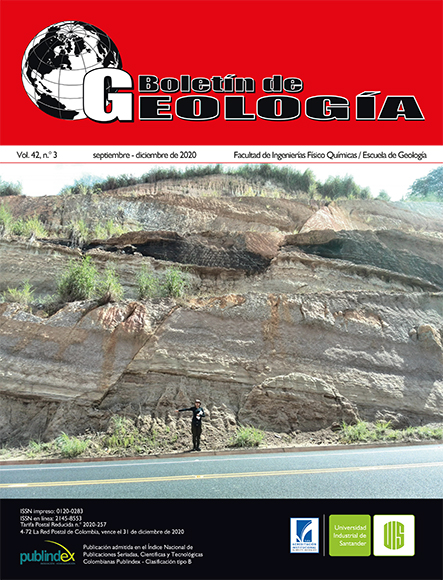1D petrophysical characterization of reservoirs in the Canning Basin, Australia
Published 2020-10-05
Keywords
- Characterization,
- Petrophysics,
- Reservoirs,
- 1D models,
- Facies
- Neural networks ...More
How to Cite
Copyright (c) 2020 Boletín de Geología

This work is licensed under a Creative Commons Attribution 4.0 International License.
Altmetrics
Abstract
The petrophysical characterization of deposits plays an important role in the oil industry, primarily in the integral management and optimization of recovery processes. The following project presents the petrophysical and facies modeling for the formational units of the Grant Group and the Anderson deposit within the Block-Bunda-3D-2009 of the Canning Basin in Australia. This proposal was divided into two stages. The conceptual stage was based on the study of hydrocarbon migration and accumulation in the area, and the creation of an inventory from the information recorded in the Western Australia Geothermal and Petroleum Information Management System (WAPIMS). The second stage was developed considering that the quantity and distribution of shales present in the sandstone, have a great impact on the productivity of hydrocarbon reservoirs. Thus, the first step was to calculate the volume of shales through the linear index of gamma rays. Subsequently, the facies were modeled using neural networks and the results were compared with the lithological descriptions reported of the full diameter drilling cores. The effective porosity was modeled by recording the volumetric density of the rock and the type of distribution of clay; water saturation by Poupon-Leveaux correlation and the horizontal permeability model was generated with conventional core drilling analysis data. It is highlighted that the presence of pyrite, affected the response of volumetric density, neutron porosity and resistivity records for some wells in the area. Likewise, the acting hydrodynamism and the presence of meteoric water in the aquifers affected the response of the resistive electrical record, making the identification of water-oil contacts complex
Downloads
References
Archie, G. (1942). The electrical resistivity log as an aid in determining some reservoir characteristics. Transactions of the AIME, 146(01), 54-62. https://doi.org/10.2118/942054-G
Arps, J. (1953). The effect of temperature on the density and electrical resistivity of sodium chloride solutions. Journal of Petroleum Technology, 5(10), 17-20. https://doi.org/10.2118/953327-G
Asquith, B. (1998). Log Evaluation of Shaly Sandstones Reservoirs: A practical guide. Volume 31, AAPG.
Cadman, S.; Pain, L.; Vuckovic, V; le Poidevin, S. (1993). Canning Basin, W.A. Bureau of Resource Sciences, Australian Petroleum Accumulations Report 9.
Chopra, S.; Michelena, R. (2011). Introduction to this special section: Reservoir characterization. The Leading Edge, 30(1), 35-37. https://doi.org/10.1190/1.3535430
Crostella, A. (1998). A review of oil occurrences within the Lennard Shelf, Canning Basin, Western Australia. Western Australia Geological Survey, Report.
Crowe, R.; Towner, R. (1976a). Definitions of some new and revised rock units in the Canning Basin. Geological Survey of Western Australia. Record 1976/24, p 23.
Crowe, R.; Towner, R. (1976b). Permian stratigraphic nomenclature (Noonkanbah 1:250000). Geological Survey of Western Australia. Annual Report – 1975, p. 56-58.
Crowe, R.; Towner, R. (1976c). Environmental interpretation of the Permian Nura Mermeber of the Poole Sandstone, Noonkanbah sheet area, Canning Basin: a gradation between fluviatile and shallow water marine facies. Western Australia Department of Mines. Annual Report 1975, p. 59-62.
Forman, D.; Wales, D. (1981). Geological evolution of the Canning Basin, Western Australia. Commonwealth of Australia.
Horsfall, O.; Davies, D.; Davies, O. (2015). Hydrocarbon reservoir characterization using well log in Niger Delta Basin of Nigeria. International Journal of Applied and Natural Sciences, 4(5), 55-64.
Hubbert, M. (1953). Entrapment of petroleum under hydrodynamic conditions. AAPG Bulletin, 37(8), 1954-2026. https://doi.org/10.1306/5CEADD61-16BB-11D7-8645000102C1865D
Illidge, E. (2017). Inversión y atributos sísmicos en la clasificación de Facies. Tesis de Maestría, Universidad Industrial de Santander, Bucaramanga, Colombia.
Kamel, M.; Mabrouk, W. (2003). Estimation of shale volume using a combination of three porosity logs. Journal of Petroleum Science and Engineering, 40(3-4), 145-157. https://doi.org/10.1016/S0920-4105(03)00120-7
Kennard, J.; Jackson, M.; Romine, R.; Southgate, P. (1994a). Canning Basin project Stage - II – Geohistory Modelling. Australian Geology Survey Organization.
Kennard, J.; Jackson, M.; Romine, K.; Shaw, E.; Southgate, P. (1994b). Depositional sequences and associated petroleum systems of the Canning Basin, W.A. Western Australian Basin Symposium, Perth, Australia.
Klimentos, T. (1995). Pyrite volume estimation by well log analysis and petrophysical studies. The Log Analyst, 36(6), 11-17.
Kumar, M.; Dasgupta, R.; Singha, D.; Singh, N. (2018). Petrophysical evaluation of well log data and rock physics modeling for characterization of Eocene reservoir in Chandmari oil field of Assam-Arakan basin, India. Journal of Petroleum Exploration and Production Technology, 8(2), 323-340. https://doi.org/10.1007/s13202-017-0373-8
Martinez, D.; Winkler, F.; Granados, L. (1983). The Carboniferous of the World. Volume 2 publication Issue 20. International Union of Geological Sciences Publication. Instituto Geológico y Minero de España.
McWhale, J.; Playford, P.; Lindner, A.; Gleinster, B.; Balme, B. (1958). The stratigraphy of western Australia. Journal of the Geological Society of Australia, 4(2), 1-153.
https://doi.org/10.1080/00167615608728471
Mory, A. (2010). A review of mid-Carboniferous to Triassic stratigraphy, Canning Basin, Western Australia. Geological Survey of Western Australia. Report 107.
Poupon, A.; Leveaux, J. (1971). Evaluation of water saturation in Shaly Formations. SPWLA 12th Annual Logging Symposium. Dallas, USA.
Rojas, D.; Cabrera, M. (2019). Caracterización petrofísica de yacimientos implementando atributos e inversión sísmica. Tesis, Universidad Industrial de Santander, Bucaramanga, Colombia.
Rudge, T. (2010). Bunda 3D 2009 Seismic Survey Interpretation Report L6, L8 and EP104 R5. Submitted to the Department of Mines and Petroleum, West-Australia. Buru Energy.
Thomas, E.; Stieber, S. (1975). The Distribution of Shale in Sandstones and its effct upon porosity. SPWLA 16th Annual Logging Symposium, New Orleans, USA.

